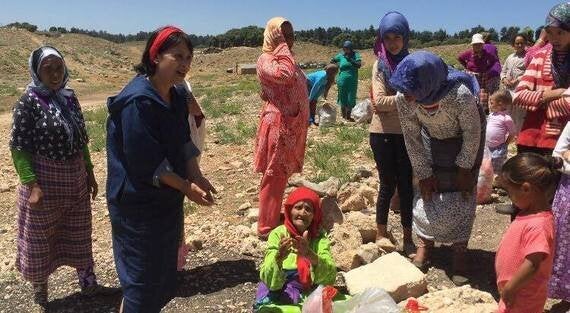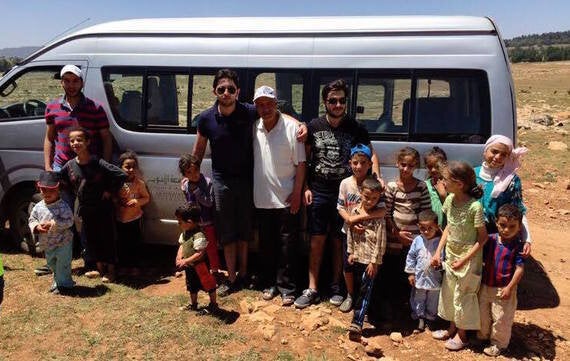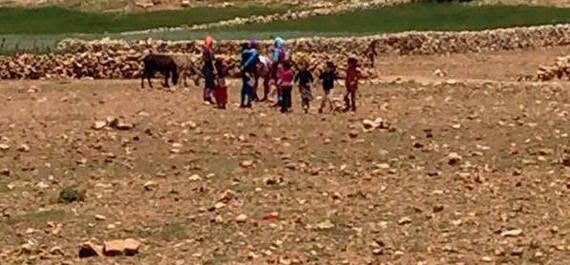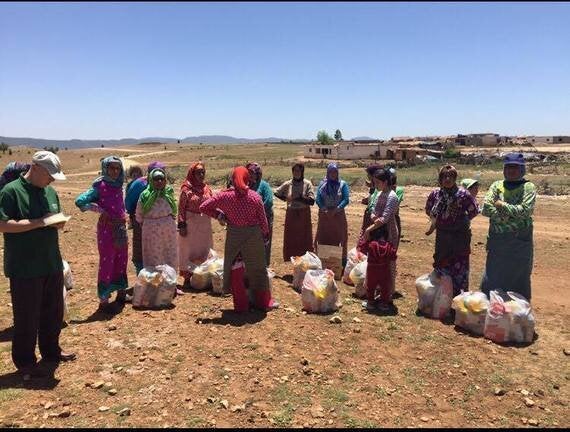"There is nothing but stones here," says Ouafaa Berrada, as our convoy of small trucks turns into the Valley of the Rocks. We loaded them in the morning with foodstuffs and gallons of fluids for poor and vulnerable families living in the barren landscape of Morocco's mid-Atlas mountains.
It is Ramadan, the holy month of the Islamic world, when people are encouraged to be especially generous towards the poor. Indeed, one of the purposes of the practice of fasting during the month is to help the "haves" directly experience the hunger of the "have nots".

As in so many parts of the world, the bright colours of the women's clothing - turquoises, deep blues, reds, purples and tangerine orange - along with the open sky and the natural panorama - play tricks on the mind of the visitor. Rural poverty always seems to leave us feeling that it is somehow less crushing than that found in the crowded slums of the cities.
But when you come close to their makeshift dwellings huddled together in the midst of the stony fields that stretch as far as the eye can see - and when you see the women and children making their way over the stony ground towards our convoy, the plight of these people is unforgettable.
Stones, scrap metal and plastic sheeting
Our convoy is organized by Ouafaa Berrada (above, second from left), an urban sociologist, who spearheads this operation as a volunteer. She is a member of the board of the regional development association and vice-president of the Moroccan League for the Protection of Children. Her husband is the Director of the Language Centre at the University of Al Akhawayn in the city of Ifrane, 300 metres (1,500 ft) above sea level.
The university provides a small storeroom for this charitable work and has loaned two of its vans to take the provisions into the harsh mountain areas that surround the city. Our team consists of one of the university doctors, half a dozen students, and Esma Laamiri, wife of the university's finance director.
At the first stop, our convoy is met by some of the families who live in rough shacks made from stones, scrap metal and plastic sheeting. We see them making their way towards us in the distance over scrub land and dirt tracks. Soon we are surrounded by a couple of dozen women, young children and a few older men.
We stop outside a small, one-room school that has been constructed here, the only concrete building visible for miles. The doctor begins calling out the names of the families. As the women identify themselves, they receive plastic bags packed with beans, chick peas, flour, dried fish, and oil, as well as sugar, tea and a large jug of a local high energy drink. The work together to help the weakest among them as they struggle with the weight of the provisions.
The team does this work year round. They also take clothing and shoes to the families and provide socio-medical care.
Their work is well known in this area . The visits are announced in advance. Over the years they have been doing this, they have learned from their experience - the result is meticulous record keeping and a precise distribution method.

While the children run around and gather for photos beside the vans, doctor Guennoun works his way through his list, requiring each family representative to show their identity card before authorizing them to collect their share of the aid.
Working through the womenfolk
"We have learned to put our trust in the womenfolk," Ouafaa tells me. "After a lot of experience, we have developed this system. We give the provisions to the women who identify themselves with their carte d'identité. This ensures that what we bring is treated properly and goes direct to the families. It also means that the children eat well."
After half an hour, we head further into the valley, past some herds of small brown sheep. They graze among the endless rocks for green shoots and provide the only income for the people who have settled here in small clusters not locatable on any map.
"How did you find these poor communities?" I ask Ouafaa. "I went looking for them," she says. "I knew they must be out here. It is in rural areas like this that the vast majority of the poor of our country live."
The Valley of the Rocks is surrounded in the distance by forests, but in the valley where she found these people, there are few trees, and little shade from the strong North African sun.
"I see solar panels on top some of the dwellings. How did the people manage to get these?" I ask. "These were a gift through Al Akhawayn University," Ouafaa tells me. "There is no electricity or state water supply out here."
Absolute poverty
The government's National Report 2015 "Morocco between Millennium Development Goals and Sustainable Development Goals" acknowledges that while the country's absolute poverty rate between 2001 and 2014 was reduced by more than two-thirds, there remain 5.3 million Moroccans living either in absolute poverty (1.4 million) or vulnerability (3.9 million). The rural areas account for 85% of the poor and 64% of the vulnerable.
In October 2015, the World Bank updated the international poverty line to US$1.90 (1.68 Euros, £1.32) a day. The poor here likely live below that.
These statistics come to life in the Valley of the Rocks.

At the next stop, the people we meet have brought with them donkeys to help carry the heavy bags of provisions back to their homes. A small complement of dogs has joined in as well. Nearby I count 15 shacks, the sun beating down on the torn black and faded green plastic sheeting and the rusted metal scraps.
"These are Berber people," Ouafaa tells me. "Like most of the rural poor they are illiterate. Most of them speak only their own language and not Arabic. The children are able to go to the school where we made our first stop. It's a long walk for them - 4 or 5 kilometres. It's even harder in winter through the mountain snow."
At our third and last stop, Doctor Guennoun makes a final record of everything that has been distributed, working his way through the sheets of names and identity numbers. "One hundred and ninety six packages distributed today," he announces, a warm smile of accomplishment breaking across his face.

One of the students, having witnessed the harsh realities of life for these people living close to the university - and yet in another, utterly different world - asks if it is possible to give money to the people, not only provisions.
"They have no idea that people live like this"
"If people want to give money," Ouafaa tells her, "they can first email me. We then go through the regional association ADMA (Association pour le Développement de Moyen Atlas). That guarantees transparent record keeping. We can help anyone arrange this who wants to support our work." Her email is: ouafaaberrada@gmail.com
"One of our main objects," she tells me, "is not only to bring relief to these people, but also to raise the awareness of the university students by involving them in work for human beings who live in such desperate conditions. Otherwise, they have no idea that there are people living like this."
The noon prayers finish at our final stop. The imam gathers his people around him to give thanks and offer a blessing. The women fill the air with their high pitched ululation.
As we drive away, returning from our mission of mercy, we look back to see them turning around into the valley, making their way home among the stones.
"We will be back," says Ouafaa. "They know they can count on us. Next week we hope to bring enough food parcels for 500 families. It means we can go to the other communities we were unable to visit today."